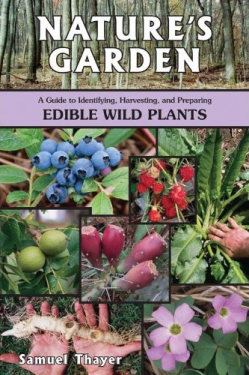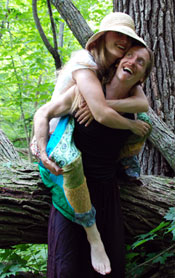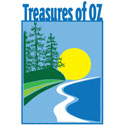There is no feeling quite like wandering off into the neighboring woods and returning with baskets full of wild edibles. These are the ultimate health foods — about as 100% organic as you can get, and many of them are surprisingly yummy. Even more significantly, learning about wild edibles re-connects us with nature. When all of our food comes from the grocery store, it’s easy to forget that what we eat comes from living plants and animals. In the wilds, that fact is ever-present.
 Even children can go out and easily identify delicious natural treats. Wood sorrel is a great example with its tangy flavour, and during a recent ‘survival’ class that we taught for third graders, the children tasted ‘Golden Birch’ (yellow birch), and were delighted with the minty taste of the buds.
Even children can go out and easily identify delicious natural treats. Wood sorrel is a great example with its tangy flavour, and during a recent ‘survival’ class that we taught for third graders, the children tasted ‘Golden Birch’ (yellow birch), and were delighted with the minty taste of the buds.
Learning wild edibles, however, isn’t always that easy. Field guides can leave you in doubt about identifying plants, and the negative mystique built up around wild edibles (Wild plants are poisonous! They’ll kill you!) has created a culture of doubt and fear around the whole subject.
For us, Samuel Thayer came to the rescue. His first book on edible plants, The Forager’s Harvest, introduced us to a new way of establishing a relationship with wild foods. Samuel doesn’t perpetuate the negative mystique — he not only eats all the plants he writes about, but during his classes he has his students eat them. From notes about where to find the plants, how to harvest and prepare them, and how they taste, his knowledge is based on personal experience. The result is that you become intimate with each plant he describes. The Forager’s Harvest opened new worlds of wild food exploration for us — including introducing us to some wild foods that were right in our own yard!
Now Samuel Thayer has worked his magic a second time with Nature’s Garden. Continuing in the tradition of his first book, he covers less species than conventional guides, but each species is introduced with stories, detailed descriptions, photos of all the edible parts, and personal accounts that leave you feeling like each plant is a new best friend. Prior to the actual plant descriptions, Samuel delivers a wealth of information on poisonous plant fables (including his take on Chris McCandless’s supposed poisoning by wild sweet pea), an account of Samuel and his wife eating ‘wild’ for an entire month, notes on conservation, a wild food calendar, and a chart showing the percentage of plants in the book that grow in each of the states and Canadian provinces.
Each time we open Samuel’s books, we find old myths turned on their heads, and feel renewed confidence in our ability to enjoy wild foods. This year we have a host of new plants to explore, thanks to Nature’s Garden. If you’re interested in edible wild plants and want a truly helpful guide, both of Samuel’s books are a must in your library.
Now, we’re off to see what green things are poking through recently-thawed earth . . .
Posted on April 9th, 2010 by Kenton and Rebecca
Filed under: Plants, Reviews




I love the edible flowers our CSA gives up with our greens. They have a really unique flavor and look cool in the salad.
My favorite is wild raspberries, yum!
Oh yes, raspberries indeed. Samuel Thayer’s last book led us to tasting Black Locust blossoms, which are now one of our very favorite wild edibles. Absolutely delicious if you can catch them at their prime.
Lovely white flowers from blackberry plants are covering parts of the pine flatwoods here in Florida. Beautiful!
Hi Gropius,
Well, you’re a little ahead of us here in Wisconsin — it must be gorgeous! And those are such delicious berries . . .
[...] This post was mentioned on Twitter by Margie. Margie said: Wild About Nature Blog » Samuel Thayer's “Nature's Garden” http://bit.ly/dxUC0b [...]
Love these books! For me the biggest transformation was that milkweed does not in fact need to be boiled in multiple changes of water. Anyone who can trump Euell Gibbons’ expertise is a hero in my book!
Hey Elizabeth,
Absolutely — this guy knows his stuff. The milkweed myth exploded, all sorts of edible parts of plants we were already familiar with, a great education about the nightshade family, and so much more — there is so much to learn! Glad you’re a fan =)
Euell Gibbons’ writings opened up a whole new world of outdoor experience for me when I was a young man even though I came from a family that picked a lot of wild mushrooms, berries, and fruit. For working with young children I can recommend “Plantworks” by Karen Shanberg and Stan Tekiela, two wonderful Minnesota-grown naturalists. It uses a few common plants that are impossible to mistake and introduces some nice basic recipes.
I’ve read that an indicator of the disconnect in our society is that young people don’t know where their food comes from. I think a book like “Plantworks” helps bridge that chasm.
Hey KB!
We hadn’t heard of that one! We’ll have to check it out. We’re becoming fans of books that give less quantity of information and more quality of information. For so long our edible plants guide was a big Peterson’s field guide or something, which gave you the impression that there were tons of things to eat out there, but didn’t make it very easy to identify them or know what parts to eat or how to prepare them.
I just got Samuel Thayer’s Nature’s Garden a few days ago. You are right! It is the best wild edibles book ever written. I have dozens, and the closest thing to it is depth is Steve Brill’s How to Find Wild Edible Plants in Wild and Not So Wild Places. But the quality of the photos and paper in Thayer’s book makes it a real treasure.
I, too, really appreciated seeing the record straightened on what really killed Christopher McCandless. And even though I understood that our body needs a certain number of calories per day, I had never put it together what that actually meant in terms of wilderness survival.
The most surprising revelation in the book, to me, was that black nightshade berries are edible. Can’t wait till they ripen around here to try them.
Glad I found your blog!
Hi Sharon,
Learning about the black nightshade berries was an amazement for us, as well. We, too, are waiting in breathless excitement to try them out. Grow, nightshade, grow!
We love the concept of your blog, by the way, and will be posting you on our Awesome Nature Blogs blogroll. May you and Ron continue to have fun adventures!
Thanks so much! I’ve added you to my favorite blogs list, too.
Ron and I are anxiously awaiting mushroom season, and it’s just around the corner. He’s the spotter, and I’m the identifier!
Don’t forget John Kallas book, “Edible Wild Plants.” Samuel Thayer gave the book 5 stars (highest rating) on amazon. Sam even suggests his old news letter (no longer in print) as a resource in the back of Foragers Harvest. John Kallas and Samuel Thayer present things in the same manner, and both have even commented on their respected web sites how much they think alike.
Hi Marc,
Thanks for the recommendation! We haven’t yet read John Kallas, but he’s on our list!
Thayer’s books are amazing. Nature’s garden would be worth the price just for the section on acorns, but the rest is brilliant too.
Kallas’ book is as detailed and reliable as Thayer’s. It is the 1st in a series, and only covers greens.
If you ever want the most comprehensive resource, Native American Ethnobotany is massive. It compiles over 40,000 plant uses from over 4,000 plants that were used by Native American’s. It isn’t the same kind of book as the other foraging books mentioned, but if you want a broad understanding of how many ways plants can be used to meet daily needs, this is the book.
Nate
Hello Nate!
Thanks for turning us on to the ‘big book’. It’s not in our collection, but it sounds like it should be.
We love your site — ‘aspiring hunter/gatherer’. Way to go! That’s an aspiration we can definitely get behind.
Hugs,
Kenton and Rebecca
Do you have a book that tells of only the plants that grow in the state or area of a state that you live in?
Hi Frankie,
Sam’s books are very “local” if you live in Wisconsin, Minnesota, or Michigan. If you live in another state, more and more books are coming out that are specific in scope. Check out your library or local book store, and hopefully you’ll find some great stuff!